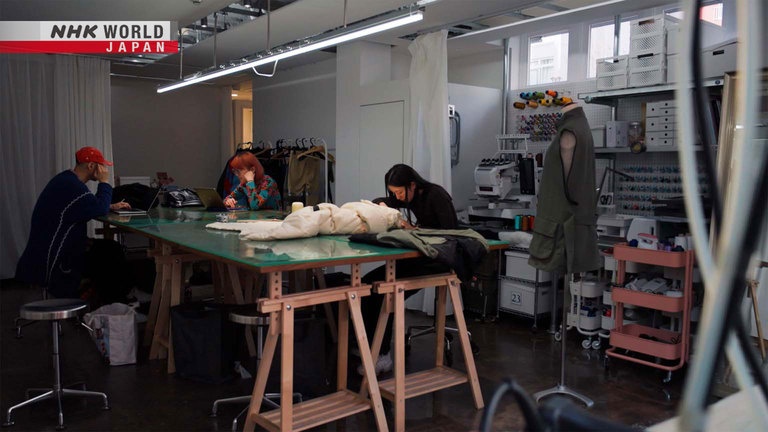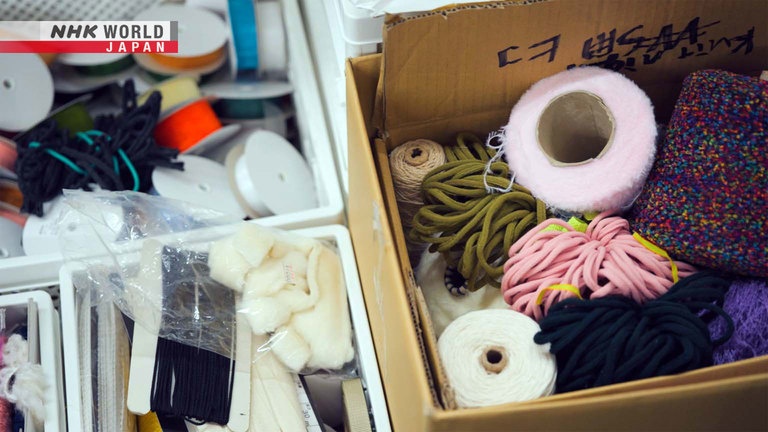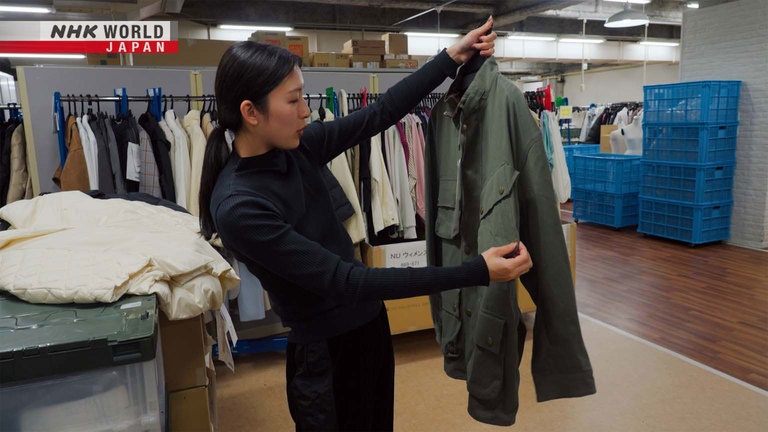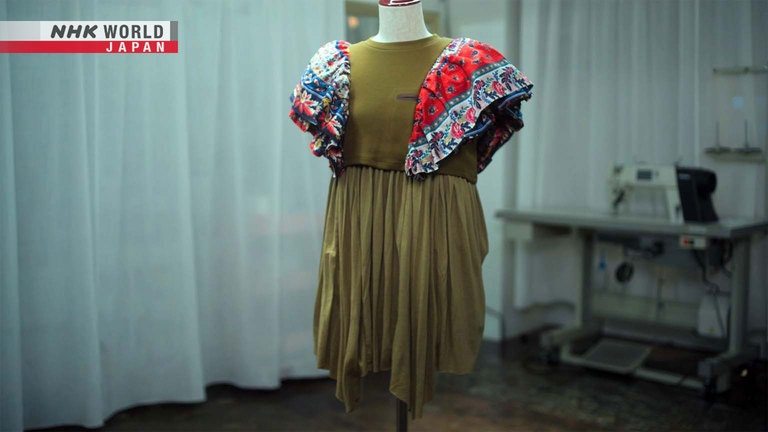Clothing Rescue Atelier
At Yoshimura Mayu's atelier anyone can come in and make clothes. The materials are discards from industry and major brands. And working together leads to great ideas they couldn't come up with alone.




Transcript
Since ancient times, the Japanese have believed that a life force resides in all creations.
Valuing and caring for the things we use, a "Zero Waste Life."
Pointing the way to better living for a new era.
It won't work unless we're in it together.
We need a group space to make things
in a way that makes everyone happy.
Tokyo's trendsetting Harajuku area.
Here, we find a different kind of atelier.
A shared workspace for clothing makers.
Anyone who registers can use it at no cost.
The materials used are discards from apparel brands and other sources, set for disposal.
Nearly everything here was once headed for the scrap heap, including sewing machines and other tools.
The atelier is run by clothing designer Yoshimura Mayu.
Negotiating with apparel brands, she's managed to acquire all kinds of things,
some more unusual than others...
Like this book of button samples.
It would be difficult to dispose of without
removing the buttons one by one,
so they gave it to us, and we've been
using them straight from the book.
The makers here range from beginners to veterans,
all kinds of users hard at work on their creations each day.
It feels wasteful to me using new
material just to make more trash.
So, as a gateway to clothes making
this place was a perfect fit.
We're multigenerational, so you can
see different values and sensibilities.
It's really exciting.
I've never seen anything like it.
Every piece created at the atelier has a distinctive design.
The clothing they make is showcased at events and posted on social media, as an appeal for reusing waste materials.
Today, Yoshimura is collecting discards for use in the atelier.
These are all hang-up items; foldable ones
are below and in these plastic cases.
Feel free to look.
- Thank you so much.
- It's our pleasure.
Items with minor defects, that occurred during production, or even the slightest damage are unsellable.
Yoshimura is given clothing with nowhere else to go, by fashion brands, free of charge.
I look for texture combinations,
interesting materials,
things that look easy to disassemble.
I also try to eliminate waste by picking
ones that can used in their entirety.
Thank you. Goodbye.
On this day, she returns with seven carefully selected items.
She relates the details of what she's gotten to the atelier's users.
Good morning!
First to arrive is children's clothing specialist Takahara Ryo.
- You working on kids' ware today?
- Yes, as usual.
It's easy to make kids' clothes from ones
for adults; these patterns are all I need.
Takahara will use this fake-fur jacket and plaid coat as his main materials.
From the cuffs of the original,
the tabs on the trench coat.
I put them on the shoulders;
something like epaulets.
After half a day's work, it's complete.
Items destined for disposal, re-envisioned as a charming child's coat,
the collar and cuffs adorned with fur.
Traces of the originals are everywhere,
like this buttonhole right here.
You just used it as is? Amazing!
I don't design, I just use the design
that came from the original clothing.
So cute. Just lovely, as expected.
Okay, pose!
So cute!
Yoshimura started her career making showy theatrical costumes.
But while she was passionate about her work, she also felt a certain inner conflict.
Trying to make things well, you also see
that so many things go to waste.
It's a shame doing it again and again.
We were throwing so much away.
Make and discard, make and discard.
It was an uncomfortable feeling.
Three years ago she started the atelier with some like-minded others, to rescue clothing slated for disposal.
But in the beginning there was little understanding from apparel brands.
They thought it would harm their brand
if we altered what they had made.
Gaining their trust proved difficult.
It was extremely challenging.
Yoshimura put out a series of design sketches with her friends to get the brands' approval.
Their continued enthusiasm helped secure sources of clothing.
The atelier now receives discards from many well-known brands, and has over 1,000 registered users.
It was fun figuring it out together.
It wasn't just me alone, but all of us.
We all feel it's wasteful to make things
and then just throw them away.
That's why we relate so well.
Today, Yoshimura will make something herself for the first time in a while.
She's chosen a coat and vest.
The coat, however, has a serious issue.
There's a stain here.
That's why they couldn't sell it.
I'll have to find a way to hide it.
It's big and probably won't come out.
First, to break down the coat.
She deliberately avoids using scissors.
If you cut with scissors, the area
around the seams is wasted.
But I figured out that if you iron it
you can make use of that too.
I insist on it.
The sections removed from the coat will be sewn onto the vest.
Perfect.
A Cinderella fit.
- The sleeves look great.
- They do.
- Even the underside.
- Nice!
- It really is.
- Amazing!
It's time for the finishing touches.
But, Yoshimura seems concerned.
She'd planned to cover the stain on the coat with a cutoff from a down jacket...
but can't seem to get it right.
Could I get some ideas?
This stain here, I want to hide it.
- Where does it end? Oh, it's pretty big.
- I know. It's in a tricky spot.
Yeah, not good at all.
The problem is that it's too close to the belt.
Sewing the cutoff over the stain would leave no gaps, harming the overall balance.
- The belt's cute.
- Yeah, I don't want to ruin it.
How to hide the stain and keep the belt?
After an hour and a half of worrying...
Couldn't you move the belt loops?
No problem. They're pretty low.
To shift the balance of the design, she decides to raise the belt, which had been low on the waist.
If you just cover the stain here
the balance isn't bad.
It's pretty cute.
- Yeah. Maybe add a belt loop?
- You're right! I'll do it!
You should. As many as you like.
At last a solution!
Adding belt loops in a higher position, the stain can be covered without looking out of place.
The hem has a notched design, reminiscent of a tailcoat.
It can be layered with the long-sleeved jacket.
These pieces are the only unused fabric.
- It came out really cute.
- Great! So cute!
It looks good. You could sell it as is.
Really?
I'm sure people will love it.
I'm so glad. Thanks!
We inevitably have to throw things out.
But everyone needs to consider
what we can do about it.
I want this to be a place where
people can exchange opinions
and come up with real solutions.